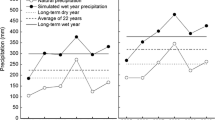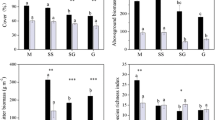Abstract
The major aims of this study were, firstly, to analyse the grazing-induced steppe degradation process and, secondly, to identify an efficient and sustainable grazing management system for the widely degraded Inner Mongolian typical steppe ecosystem. From 2005–2008 a grazing experiment was conducted to compare two grazing management systems, the Mixed System (MS) and the Traditional System (TS), along a gradient of seven grazing intensities, i.e. ungrazed (GI0), very-light (GI1), light (GI2), light-moderate (GI3), moderate (GI4), heavy (GI5), and very-heavy (GI6). Each grazing intensity treatment was considered a production unit comprising two adjacent plots, one for hay-making (single-cut system) and one for grazing. Hay-making and grazing alternated annually in the MS, while in the TS the same plots were used either for hay-making or for grazing. Effects of management system, grazing intensity, and year on end-of-season standing biomass (ESSB), aboveground net primary production (ANPP), relative difference in ANPP between 2005 and 2008 (ANPPDiff), relative growth rate (RGR), and sward characteristics (litter accumulation, soil coverage) were analysed. Litter accumulation of production units was affected by grazing intensity (P < 0.001) and decreased from GI0 to GI6 by 83%. Correspondingly, soil coverage decreased (P < 0.001) from GI0 to GI6 by 43%, indicating an increased vulnerability to soil erosion. We found varying compensatory growth responses to grazing intensity among years, probably because of temporal variability in precipitation. The ability of plants to partially compensate for grazing damage was enhanced in years of greater seasonal precipitation. The ANPP of production units was negatively affected by grazing intensity and decreased from GI0 to GI6 by 37, 30, and 55% in 2006 (P < 0.01), 2007 (P < 0.05), and 2008 (P < 0.001), respectively. The effect of management system × grazing intensity interaction on ANPP (P < 0.05) and ANPPDiff (P < 0.05) suggested greater grazing resilience of the MS as compared to the TS at GI3 to GI6.




Similar content being viewed by others
Abbreviations
- ANPP:
-
Aboveground net primary production
- B:
-
Block
- DM:
-
Dry matter
- ESSB:
-
End-of-season standing biomass
- GI:
-
Grazing intensity
- SY:
-
Management system
- MS:
-
Mixed System
- RGR:
-
Relative growth rate
- TR:
-
Target range
- TS:
-
Traditional System
- YR:
-
Year
References
Allen VG, Bagley P, Ballerstadt P, Baxter H, Bransby DI, Brown TF, Buxton D, Child D, Coffey J, Degarmo H, Fribourg HA, Hood M, Horn F, Johnson DA, Kesler E, Khattat F, Kothmann M, Lacefield G, Martz F, Matches AG, McCawley P, Pearson H, Phillippi D, Reid L, Sleper D, Staples C, Undersander D, Vough L, Wallace JD, Williamson R, Willoughby J, Hodgson J, Minson D (1992) Terminology for grazing lands and grazing animals. J Prod Agric 5:191–201
Bai Y, Han X, Wu J, Chen Z, Li L (2004) Ecosystem stability and compensatory effects in the Inner Mongolia grassland. Nature 431:181–184
Bai YF, Wu JG, Xing Q, Pan QM, Huang JH, Yang DL, Han XG (2008) Primary production and rain use efficiency across a precipitation gradient on the Mongolia plateau. Ecology 89:2140–2153
Bai YF, Wu JG, Clark CM, Naeem S, Pan QM, Huang JH, Zhang LX, Han XG (2010) Tradeoffs and thresholds in the effects of nitrogen addition on biodiversity and ecosystem functioning: evidence from inner Mongolia Grasslands. Global Change Biol 16:358–372
Biondini ME, Patton BD, Nyren PE (1998) Grazing intensity and ecosystem processes in a northern mixed-grass prairie. USA Ecol Appl 8:469–479
Briske DD (1993) Grazing Optimization—a plea for a balanced perspective. Ecol Appl 3:24–26
Caldwell MM, Richards JH, Johnson DA, Nowak RS, Dzurec RS (1981) Coping with herbivory—photosynthetic capacity and resource-allocation in 2 semi-arid Agropyron bunchgrasses. Oecologia 50:14–24
De Mazancourt C, Loreau M, Abbadie L (1998) Grazing optimization and nutrient cycling: when do herbivores enhance plant production? Ecology 79:2242–2252
Fernandez-Gimenez ME, Allen-Diaz B (1999) Testing a non-equilibrium model of rangeland vegetation dynamics in Mongolia. J Appl Ecol 36:871–885
Ferraro DO, Oesterheld M (2002) Effect of defoliation on grass growth. A quantitative review. Oikos 98:125–133
Fisher RA (1921) Some remarks on the methods formulated in a recent article on "The quantitative analysis of plant growth". Ann Appl Biol 7:367–372
Gao Y, Wang DL, Ba L, Bai YG, Liu B (2008) Interactions between herbivory and resource availability on grazing tolerance of Leymus chinensis. Environ Exp Bot 63:113–122
Glindemann T, Wang C, Tas BM, Schiborra A, Gierus M, Taube F, Susenbeth A (2009) Impact of grazing intensity on herbage intake, composition, and digestibility and on live weight gain of sheep on the Inner Mongolian steppe. Livestock Science 124:142–147
Hilbert DW, Swift DM, Detling JK, Dyer MI (1981) Relative growth-rates and the grazing optimization hypothesis. Oecologia 51:14–18
Hoffmann C, Funk R, Wieland R, Li Y, Sommer M (2008) Effects of grazing and topography on dust flux and deposition in the Xilingele grassland, Inner Mongolia. J Arid Environ 72:792–807
IUSS Working Group WRB (2006) World reference base for soil resources 2006, 2 edn. World soil resources reports. FAO, Rome
Kang L, Han XG, Zhang ZB, Sun OJ (2007) Grassland ecosystems in China: review of current knowledge and research advancement. Phil Trans Roy Soc Lond B Biol Sci 362:997–1008
Leriche H, Le Roux X, Desnoyers F, Benest D, Simioni G, Abbadie L (2003) Grass response to clipping in an African savanna: testing the grazing optimization hypothesis. Ecol Appl 13:1346–1354
Li FR, Kang LF, Zhang H, Zhao LY, Shirato Y, Taniyama I (2005) Changes in intensity of wind erosion at different stages of degradation development in grasslands of Inner Mongolia. China J Arid Environ 62:567–585
Li WJ, Ali SH, Zhang Q (2007) Property rights and grassland degradation: a study of the Xilingol Pasture, Inner Mongolia. China J Environ Manage 85:461–470
Li CL, Hao XY, Zhao ML, Han GD, Willms WD (2008) Influence of historic sheep grazing on vegetation and soil properties of a desert steppe in Inner Mongolia. Agr Ecosyst Environ 128:109–116
Liang C, Michalk DL, Millar GD (2002) The ecology and growth patterns of Cleistogenes species in degraded grasslands of eastern Inner Mongolia. China J Appl Ecol 39:584–594
McNaughton SJ (1979) Grazing as an optimization process—grass ungulate relationships in the Serengeti. Am Nat 113:691–703
McNaughton SJ, Ruess RW, Seagle SW (1988) Large mammals and process dynamics in African ecosystems. Bioscience 38:794–800
McNaughton SJ, Milchunas DG, Frank DA (1996) How can net primary productivity be measured in grazing ecosystems? Ecology 77:974–977
Milchunas DG, Lauenroth WK (1993) Quantitative effects of grazing on vegetation and soils over a global range of environments. Ecol Monogr 63:327–366
Milchunas DG, Forwood JR, Lauenroth WK (1994) Productivity of long-term grazing treatments in response to seasonal precipitation. J Range Manag 47:133–139
Milchunas DG, Varnamkhasti AS, Lauenroth WK, Goetz H (1995) Forage quality in relation to long-term grazing history, current-year defoliation, and water-resource. Oecologia 101:366–374
Noy-Meir I (1993) Compensating growth of grazed plants and its relevance to the use of rangelands. Ecol Appl 3:32–34
Patton BD, Dong XJ, Nyren PE, Nyren A (2007) Effects of grazing intensity, precipitation, and temperature on forage production. Rangeland Ecol Manage 60:656–665
Schönbach P, Wan H, Gierus M, Bai Y and Taube F (2008) Relationship between sward surface height and agronomic traits in the typical steppe of Inner Mongolia. In International Grassland and International Rangelands Congress. p. 1160. Supplementary 2008 XXI International Grassland and VIII International Rangelands Congress Proceedings, Hohote, China
Schönbach P, Wan H, Schiborra A, Gierus M, Bai Y, Müller K, Glindemann T, Wang C, Susenbeth A, Taube F (2009) Short-term management and stocking rate effects of grazing sheep on herbage quality and productivity of Inner Mongolia steppe. Crop & Pasture Science 60:963–974
Semmartin M, Oesterheld M (2001) Effects of grazing pattern and nitrogen availability on primary productivity. Oecologia 126:225–230
Sollenberger LE, Moore JE, Allen VG, Pedreira CGS (2005) Reporting forage allowance in grazing experiments. Crop Sci 45:896–900
Steel RGD, Torrie JH (1980) Principles and procedures of statistics—a biometrical approach. McGraw-Hill, New York
Steffens M, Kolbl A, Totsche KU, Kogel-Knabner I (2008) Grazing effects on soil chemical and physical properties in a semiarid steppe of Inner Mongolia (PR China). Geoderma 143:63–72
Suttie JM, Reynolds SG, Batello C (2005) Grasslands of the world. FAO, Rome, p 514
Tong C, Wu J, Yong S, Yang J, Yong W (2004) A landscape-scale assessment of steppe degradation in the Xilin River Basin, Inner Mongolia. China J Arid Environ 59:133–149
Turner CL, Seastedt TR, Dyer MI (1993) Maximization of aboveground grassland production—the role of defoliation frequency, intensity, and history. Ecol Appl 3:175–186
Van Staalduinen MA, Anten NPR (2005) Differences in the compensatory growth of two co-occurring grass species in relation to water availability. Oecologia 146:190–199
Volenec JJ, Ourry A, Joern BC (1996) A role for nitrogen reserves in forage regrowth and stress tolerance. Physiol Plant 97:185–193
Wang RZ (2004) Responses of Leymus chinensis (Poaceae) to long-term grazing disturbance in the Songnen grasslands of north-eastern China. Grass Forage Sci 59:191–195
Wang RZ, Ripley EA (1997) Effects of grazing on a Leymus chinensis grassland on the Songnen plain of north-eastern China. J Arid Environ 36:307–318
Xiao X, Wang Y, Jiang S, Ojima DS, Bonham CD (1995) Interannual variation in the climate and above-ground biomass of Leymus chinense steppe and Stipa grandis steppe in the Xilin river basin, Inner Mongolia. China J Arid Environ 31:283–299
Yu M, Ellis JE, Epstein HE (2004) Regional analysis of climate, primary production, and livestock density in Inner Mongolia. J Environ Qual 33:1675–1681
Zhao Y, Peth S, Krummelbein J, Horn R, Wang ZY, Steffens M, Hoffmann C, Peng XH (2007) Spatial variability of soil properties affected by grazing intensity in Inner Mongolia grassland. Ecol Modelling 205:241–254
Zhao W, Chen SP, Lin GH (2008) Compensatory growth responses to clipping defoliation in Leymus chinensis (Poaceae) under nutrient addition and water deficiency conditions. Plant Ecol 196:85–99
Acknowledgements
The authors would like to acknowledge the Deutsche Forschungsgemeinschaft (DFG) for funding the research group 536 MAGIM (Matter fluxes of grasslands in Inner Mongolia as influenced by stocking rate). The authors are also grateful to the IMGERS (Inner Mongolia Grassland Ecosystem Research Station) for the technical support and provision of infrastructure, to Yuandi Zhu for organisation, as well as to the numerous trained local operators as they enabled the enormous data collection by untiring efforts.
Author information
Authors and Affiliations
Corresponding author
Additional information
Responsible Editor: Ingrid Koegel-Knabner.
Rights and permissions
About this article
Cite this article
Schönbach, P., Wan, H., Gierus, M. et al. Grassland responses to grazing: effects of grazing intensity and management system in an Inner Mongolian steppe ecosystem. Plant Soil 340, 103–115 (2011). https://doi.org/10.1007/s11104-010-0366-6
Received:
Accepted:
Published:
Issue Date:
DOI: https://doi.org/10.1007/s11104-010-0366-6




